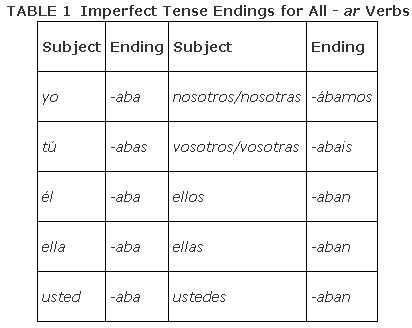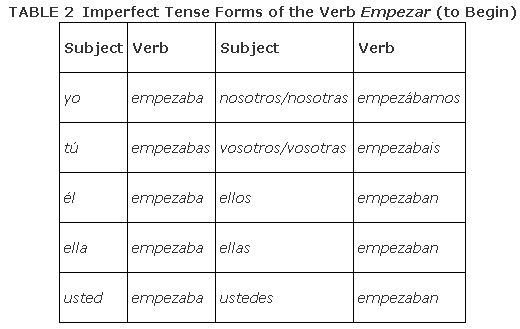Regular Verbs in the Imperfect
The formation of verbs in the preterit is much more difficult than in the imperfect. If you do not like learning irregularities, you will find the imperfect tense the most “perfect” tense. Only three verbs in the entire language are irregular in the imperfect tense.
The ‐ar endings found in Table are used for every ‐ar verb in the imperfect. There is not a single ‐ar verb that is irregular in the imperfect tense. There are no spelling changes and no stem changes in any verb in this tense. Notice that the yo form is exactly like the él, ella, and usted forms. Use a pronoun to specify the subject if it is not clear in a sentence. Also notice that only the nosotros/nosotras form carries a written accent mark.

A stem‐changing verb like empezar (to begin) does not undergo a stem change in the imperfect. Notice in Table that the verb empezar is completely regular in all forms of the imperfect tense.

The endings in Table are used for both ‐ir and ‐er verbs. Ser, ir, and ver are the only three irregular verbs in the imperfect tense; for every other ‐er and ‐ir verb, use the endings in Table . Notice that all imperfect tense forms of ‐ er and ‐ir verbs have a written accent mark on the letter i.

A regular verb like escribir (to write), conjugated in Table , serves as a good example of an ‐ir verb in the imperfect tense.

The ‐er verbs use the exact same endings in the imperfect tense as the ‐ir verbs. The verb entender (to understand) is a good example; notice in Table that entender does not undergo a stem change in the imperfect tense as it does in the present.

|
|
|
|
|
|
|
|
|
|
|
|
|
|
|
|
|
|
|
|
|
|
|
|
|
|
|
|
|
|
|
|
|
|
|
|
|
|
|
|